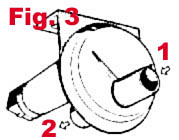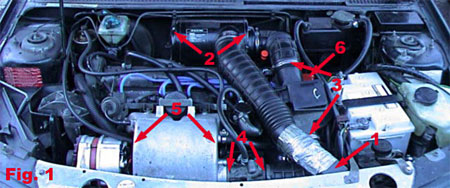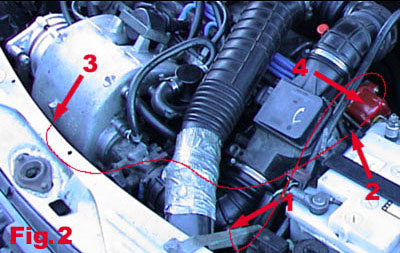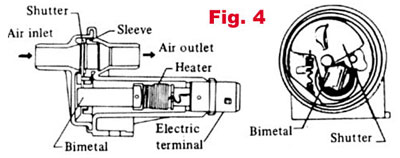
Introduction:
First, a little background:
- Air intake duct is at #1
- Air filter is inside housing between arrows at #2
- Air Flow Meter (AFM) is between arrows at #3
- Throttle body is between arrows at #4
- Intake manifold is between arrows at #5
- You can just see the distributor cap at #6

Fig. 1
Ok, so the air comes in through the intake duct at #1.
It passes through the air filter at #2 and continues along the right-angled bend into the AFM at #3.
The AFM measures the amount of air passing through it using a flap on a variable resistor. The more air entering the system, the farther the flap is forced open. As the flap moves, the resistance changes. There is also an air temperature sensor inside the AFM. The ECU uses both these values to determine the amount of fuel to be injected into the engine.
The (now measured) air continues along the other right-angled bend into the throttle body at #4.
Where is it and what does it look like?
To find the SAD, locate the hose coming from the thick tubing connected to the throttle body (#1 on Fig. 2).

Fig. 2
Trace this hose to #2 UNDER the distributor cap (#4).
You have found the SAD (Fig. 3).

Fig. 3
There is another hose which runs from the other side of the SAD (#2 on Fig. 3) to the intake manifold (#3 on Fig. 2).
The paths of the hoses may be different on your car but the red lines on this picture should help you trace them.
What does it do?
The SAD acts as the choke for the fuel injection system. When the engine is cold, it allows extra air to bypass the throttle body and go directly to the intake manifold. This is read as extra air flow by the ECU, which signals for additional fuel. The result of this is the engine revs higher to stop it stalling when cold.
How does it work?
The SAD basically allows air through it by rotating a disc with a hole in it. When the engine is cold, the hole in this disc is lined up with another hole in the SAD chamber and air passes freely to the air outlet (Pic 4). When you start the engine, a bimetallic strip inside the SAD starts to bend because of the heat generated by the engine and also by the ECU sending 12v to a small heater coil in the SAD. As this strip bends it rotates the disc which gradually closes off the airflow.
As the amount of air is reduced, the ECU processes this and reduces the amount of fuel, which in turn drops the revs.

Fig. 4
How can you test it?
- Method 1:
With the engine cold, start it and let it idle for 1 minute until it settles.
Look at Pic 2 again. Squeeze the hose coming from #1. If the idle speed drops it's a good indication the SAD is open.
- Method 2:
With the engine cold, remove the hose from the air inlet (#1 Pic 3) of the SAD. Use a mirror to look down this air inlet. You should see a hole shaped like a slice of pie at the end of the tube.
Reconnect the hose, making sure it's tight.
Start the engine and let it reach normal temperature. Even better, wring it's neck on some empty country roads ![]() .
.
Switch off the engine and remove the air inlet hose again. This time when you check the tube there should be no hole visible.
Don't forget to put the hose back on.

